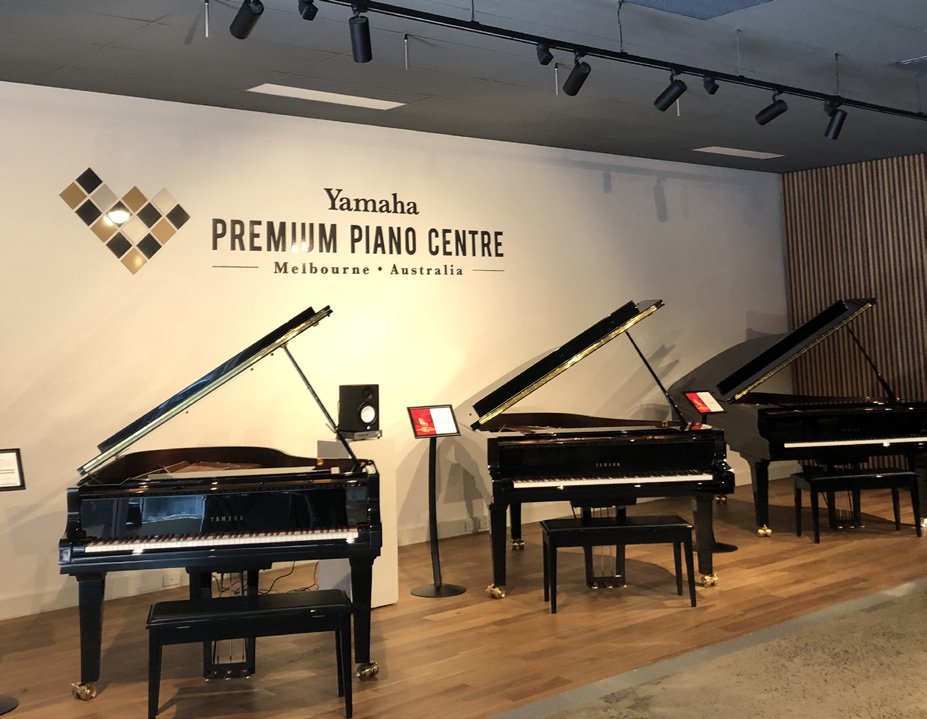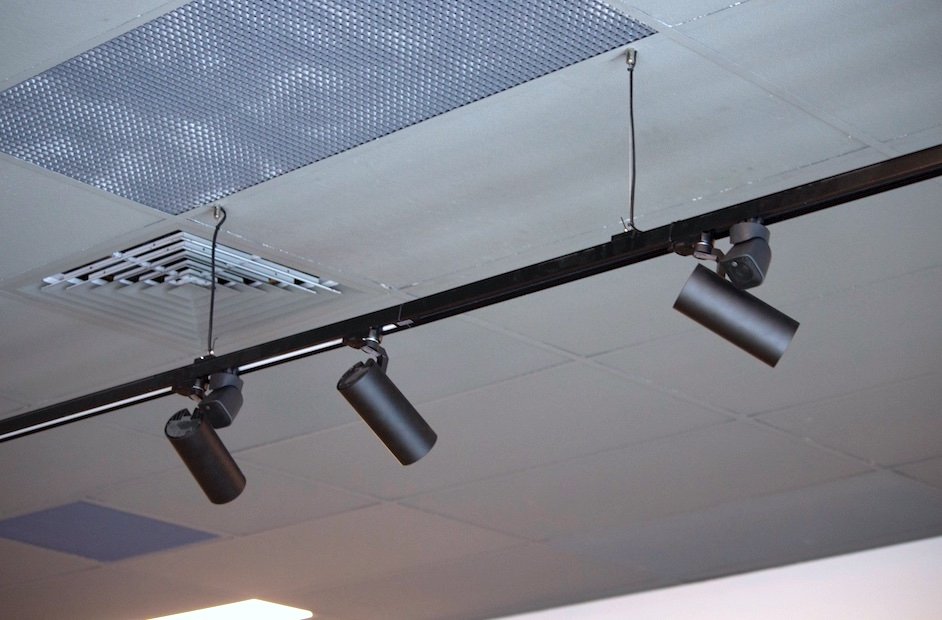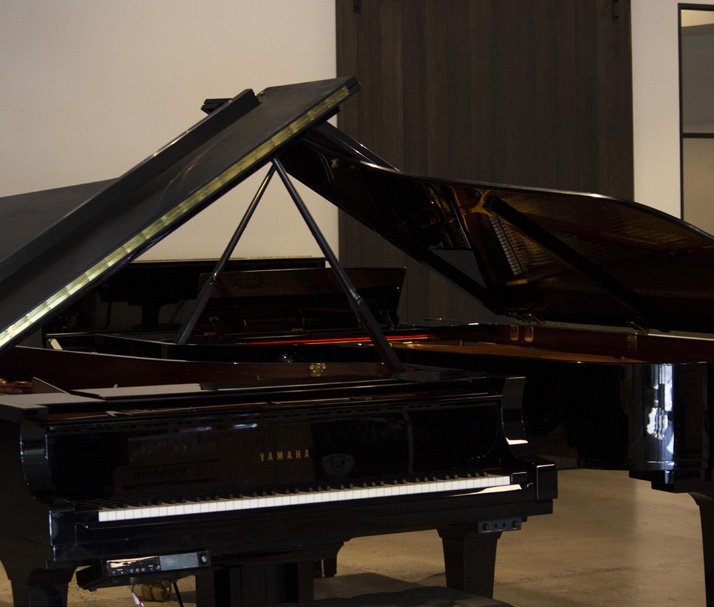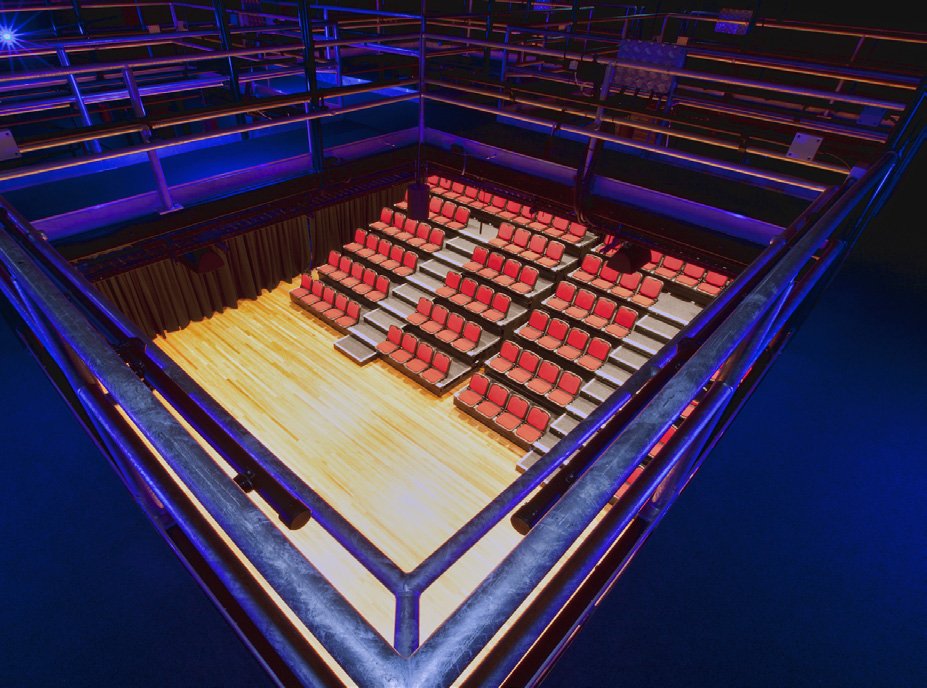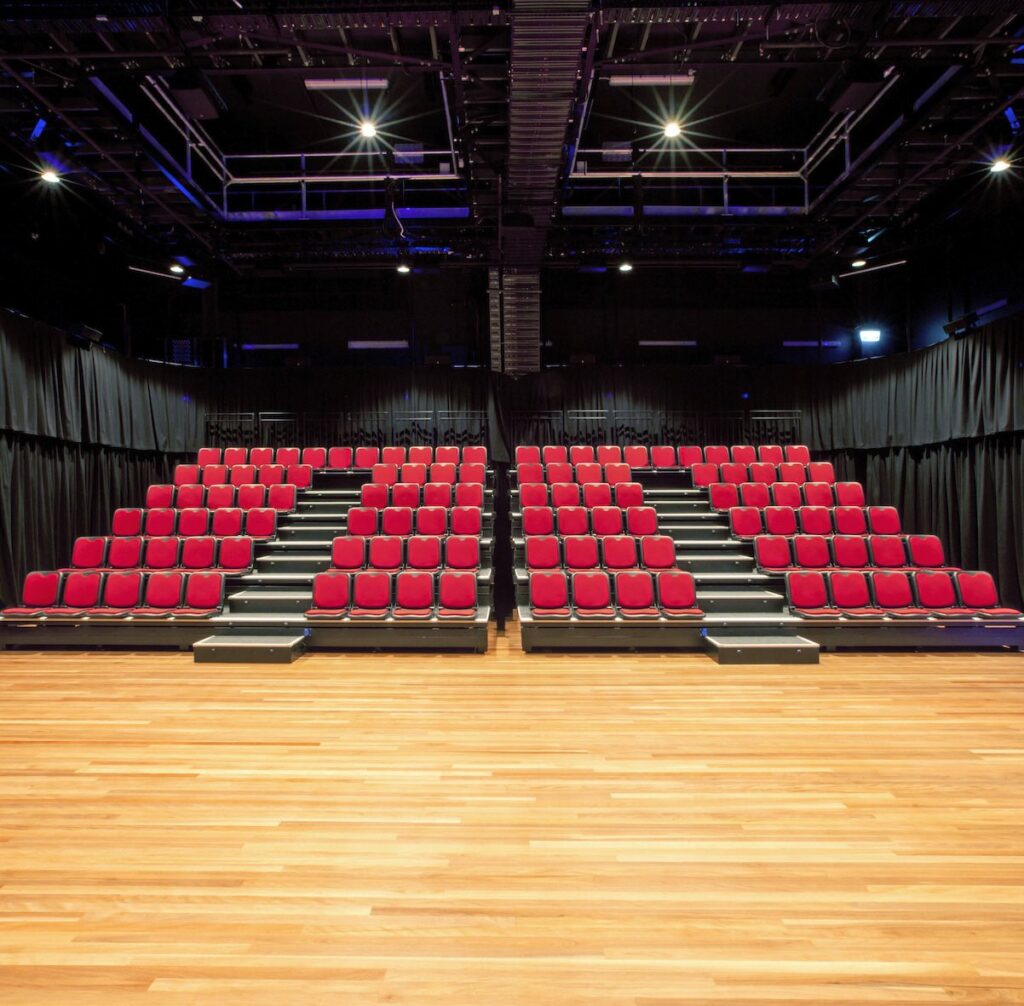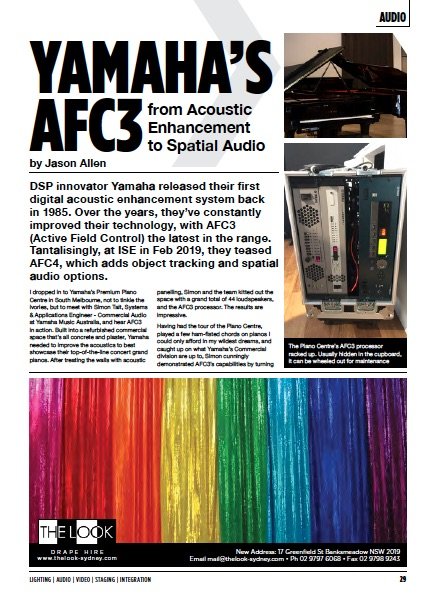News
5 Dec 2019
Yamaha’s AFC3 – from Acoustic Enhancement to Spatial Audio
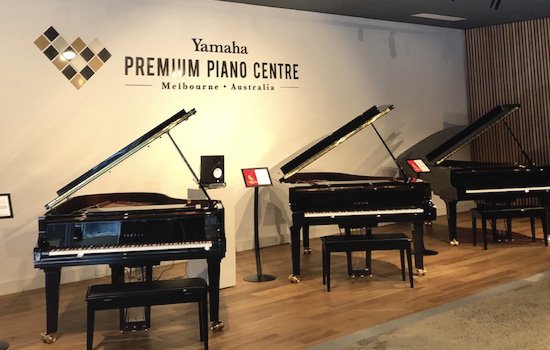
Subscribe to CX E-News
AUDIO
Yamaha’s AFC3 – from Acoustic Enhancement to Spatial Audio
by Jason Allen.
DSP innovator Yamaha released their first digital acoustic enhancement system back in 1985. Over the years, they’ve constantly improved their technology, with AFC3 (Active Field Control) the latest in the range. Tantalisingly, at ISE in Feb 2019, they teased AFC4, which adds object tracking and spatial audio options.
I dropped in to Yamaha’s Premium Piano Centre in South Melbourne, not to tinkle the ivories, but to meet with Simon Tait, Systems & Applications Engineer – Commercial Audio at Yamaha Music Australia, and hear AFC3 in action.
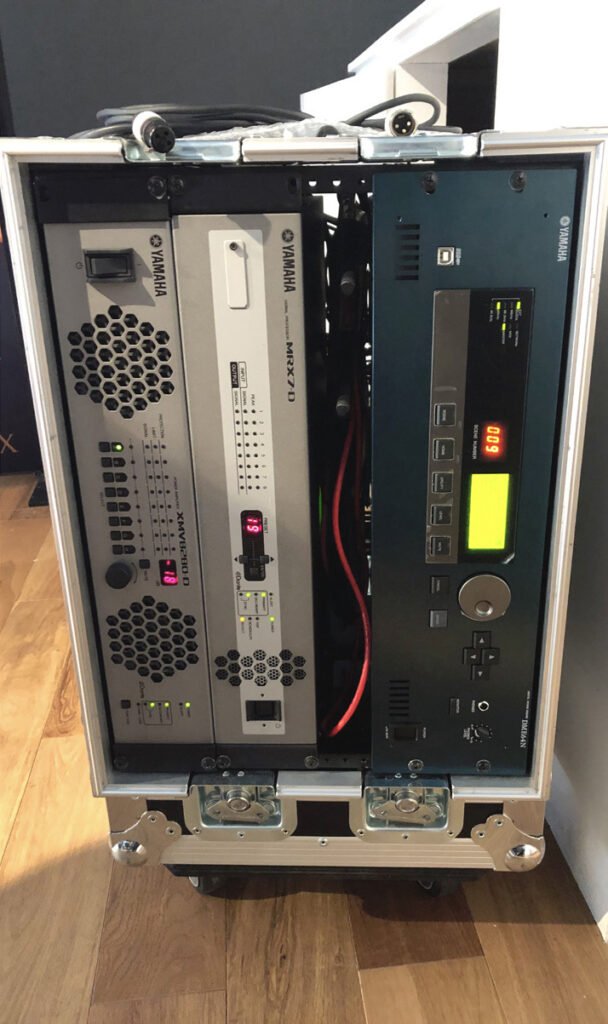
Built into a refurbished commercial space that’s all concrete and plaster, Yamaha needed to improve the acoustics to best showcase their top-of-the-line concert grand pianos. After treating the walls with acoustic panelling, Simon and the team kitted out the space with a grand total of 44 loudspeakers, and the AFC3 processor.
The results are impressive. Having had the tour of the Piano Centre, played a few ham-fisted chords on pianos I could only afford in my wildest dreams, and caught up on what Yamaha’s Commercial division are up to, Simon cunningly demonstrated AFC3’s capabilities by turning it off.
The space immediately went from a pleasantly live acoustic that my ears assumed was totally natural to almost eerily dead, and not ideal for performances on high-end pianos.
“That’s my favourite way of demonstrating what AFC3 can do,” said Simon.
“We’ve had all sorts of audio professionals in for demonstrations and done exactly the same thing to them. Even with golden ears, most don’t realise it is on either.
“The results are quite dramatic; once a vision-impaired person that was present asked to have it turned it back on because he wasn’t sure how to find his way around the room anymore.”

The AFC3 system in the Piano Centre consists of 30 tiny Yamaha VXS1ML surface mount loudspeakers fitted along lighting track, six Yamaha VSC6 6″ ceiling speakers, and eight VXS10S 10″ subwoofers cleverly concealed in the ceiling behind repurposed air-conditioning vents.
All are powered by Yamaha XMV8280-D amplifiers. A Yamaha MRX7-D processor handles system delay, EQ, limiting, and extra inputs from wall plates for presentations. All signal is distributed within the rack via Dante, and a Yamaha DCP4V4S wall panel controller provides simple preset switching and volume control.
At the heart of the system is the AFC3 processor itself, which is from the same generation of Yamaha open architecture DSP as the DME64-N, but with added AFC-specific processing and hardware modules, FIR filters, and convolution reverb processors.
The room’s natural sound is picked up from four carefully hung Rode NT55 condenser mics with omni capsules at the boundary of the space.
After the signals are sent to the AFC3, they are put through a processor-intensive process of adding reverbs, decay times, and filtering. Simon has set the AFC3 to reproduce a pleasant 2.1 second reverb time. The space now hosts internationally renowned concert pianists, jazz legends, and other Yamaha endorsees for regular concerts.
The ever-decreasing power-to-price ratio of DSP processing, ever-cheaper amp channels, and the cabling and labour savings represented by networked audio transport means that acoustic enhancement systems like Yamaha’s AFC3 are now within the financial reach of most venues and spaces. “School halls can now consider acoustic enhancement,” Simon points out.
“Anyone with a multipurpose venue that is a commercial venture should consider it, as it expands the type and variety of bookings you can take.”
Another huge upside is AFC’s potential for spatial audio. “AFC4 was announced at ISE in February,” Simon explains.
“The demonstration they ran included object-based panning. They fitted a soft toy with a tracker, and threw it around and over the audience. A violinist played sound effects that mimicked the toy’s path through the air, and AFC moved that violin signal through perceived acoustic space along the path the toy took.
“The hardware hasn’t been released yet, but we’re already scheduled for training on the new product. All this means that in the near future, when you’ve built an AFC system with distributed loudspeakers, you’ve also built a system that can do object-based panning.
“More and more venues will take up this option, as it just makes commercial sense.”
Yamaha is set to have AFC4 available early 2020 and the Audio Technology Solutions team at Yamaha Music Australia already have a series of events planned in order to discuss AFC4 concepts, system design, deployment and tuning.
To register your interest in attending a session, please visit
au.yamaha.com/audioversity
CASE STUDY
Yamaha AFC3 Active Architecture System at the University of New South Wales.
Designed to allow for creative works of every type, Io Myers Studio is a fully flexible performance space under the stewardship of UNSW’s School of the Arts & Media. It recently underwent a complete rebuild and relocation to a brand new home on UNSW’s Kensington campus, with a number of significant upgrades including a 40-channel Yamaha AFC3 Active Architecture system to control the studio’s sound field.
Io Myers Studio’s AFC3 system endows the space with instantly variable acoustics so that any conceivable type of performance can enjoy the correct sonic environment for the audience and performers alike, ranging from theatre and spoken word right through to orchestral, solo instrumental or chamber music. This new level of adaptability has led to a much wider range of bookings than was possible in the studio’s old home next door; a typical example of how an investment in variable acoustics makes artistic and commercial sense for a truly multipurpose venue.
With increasing pressure for facilities to become more multipurpose and accommodate a wider range of applications, AFC provides a cost-effective alternative to mechanical means of modifying room acoustics. It is a truly scalable solution which can be installed in a wide range of venues including (but certainly not limited to) performing arts venues, houses of worship, theatres, auditoriums, concert halls, and opera houses.
Even retail spaces have benefitted from AFC’s ability to enhance the natural acoustic environment as a way to elevate the customer’s experience. Yamaha AFC systems can be found in hundreds of facilities worldwide, and are built on the same hardware platform as Yamaha’s sound reinforcement and installation product line-up enabling highly cost-effective and flexible systems to be adapted to any sized venue.
Working alongside Kim Jones and Tom Brickhill from ARUP’s Acoustics and AV team, Yamaha designed the Io Myers Studio AFC3 system to provide fine control of early reflections, diffuse reverberance and warmth, as well as the ability to adapt to multiple seating and stage locations.
This initial design required only the room’s drawings and estimated acoustic profile, and differed very little from the final configuration. The empty room has a reverb time (RT) of about 0.9sec without the AFC3 system activated, ranging right up to 2.3sec depending on the selected preset. System tuning was carried out by Hideo Miyazaki and Dai Hashimoto of Yamaha Corporation’s Spatial Audio Group and Simon Tait of Yamaha Music Australia.
“I don’t think it is an exaggeration to suggest that this space represents a new era for Sonic Arts and music in general at UNSW, and I’m truly excited to see (and hear) what will happen as this inviting venue grows into a home for culture, community and experimentation,” said Dr. Adam Hulbert, Sonic Arts Convener at the School of the Arts and Media, UNSW.
Io Myers Studio is available for commercial hire when not being used for teaching and research activities. For enquiries please contact the UNSW Creative Practice Lab:
https://www.arts.unsw.edu.au/sam/get-involved/venues-hire
CX Magazine – Dec 2019 Entertainment technology news and issues for Australia and New Zealand – in print and free online www.cxnetwork.com.au
© CX Media
Subscribe
Published monthly since 1991, our famous AV industry magazine is free for download or pay for print. Subscribers also receive CX News, our free weekly email with the latest industry news and jobs.

